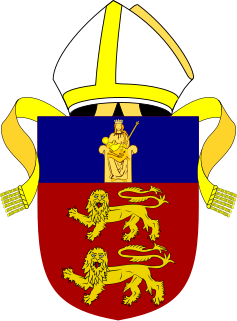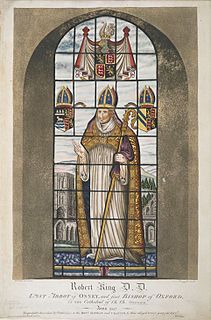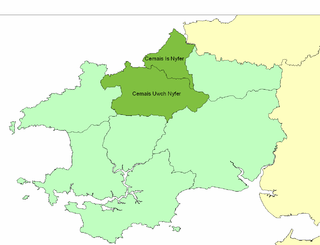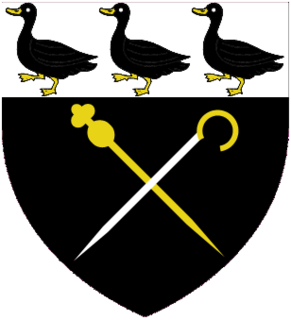
The archbishop of Canterbury is the senior bishop and principal leader of the Church of England, the symbolic head of the worldwide Anglican Communion and the diocesan bishop of the Diocese of Canterbury. The current archbishop is Justin Welby, who was enthroned at Canterbury Cathedral on 21 March 2013. Welby is the 105th in a line which goes back more than 1400 years to Augustine of Canterbury, the "Apostle to the English", sent from Rome in the year 597. Welby succeeded Rowan Williams.
A suffragan bishop is a type of bishop in some Christian denominations.
The Bishop in Europe is the ordinary of the Church of England's Diocese in Europe in the Province of Canterbury.

The Diocese of Salisbury is a Church of England diocese in the south of England, within the ecclesiastical Province of Canterbury. The diocese covers most of Dorset, and most of Wiltshire. The diocese is led by Stephen Lake, Bishop of Salisbury and the diocesan synod. The bishop's seat is at Salisbury Cathedral.

The Diocese of Lincoln forms part of the Province of Canterbury in England. The present diocese covers the ceremonial county of Lincolnshire.

The Diocese of Canterbury is a Church of England diocese covering eastern Kent which was founded by St. Augustine of Canterbury in 597. The diocese is centred on Canterbury Cathedral and is the oldest see of the Church of England.
A provincial episcopal visitor (PEV), popularly known as a flying bishop, is a Church of England bishop assigned to minister to many of the clergy, laity and parishes who on grounds of theological conviction, "are unable to receive the ministry of women bishops or priests". The system by which such bishops oversee certain churches is referred to as alternative episcopal oversight (AEO).
The Bishop of Reading is an episcopal title used by a suffragan bishop of the Church of England Diocese of Oxford, which is within the Province of Canterbury, England. The current bishop of Reading is Olivia Graham and consecrated on 19 November 2019; Graham succeeds Andrew Proud, who retired earlier in 2019.

The Diocese of Chester is a Church of England diocese in the Province of York covering the pre-1974 county of Cheshire and therefore including the Wirral and parts of Stockport, Trafford and Tameside.

The Archbishop of York is a senior bishop in the Church of England, second only to the archbishop of Canterbury. The archbishop is the diocesan bishop of the Diocese of York and the metropolitan bishop of the Province of York, which covers the northern regions of England as well as the Isle of Man. The archbishop of York is an ex officio member of the House of Lords and is styled Primate of England; the archbishop of Canterbury is the Primate of All England.

The Suffragan Bishops Act 1534 is an Act of the Parliament of England that authorised the appointment of suffragan bishops in England and Wales. The tradition of appointing suffragans named after a town in the diocese other than the town the diocesan bishop is named after can be dated from this act.

Robert King was an English churchman who became the first Bishop of Oxford.

Cemais was an ancient cantref of the Kingdom of Dyfed, from the 11th century a Norman Marcher Lordship, from the 16th century a Hundred, and is now part of Pembrokeshire, Wales. It occupied the coastal area between the Teifi estuary and Fishguard, and the northern and southern slopes of the Preseli Hills, covering an area of approximately 140 square miles (360 km2). The Afon Nyfer divided it into two commotes: Cemais Is Nyfer to the north and Cemais Uwch Nyfer to the south.
Castellan is an ancient hamlet and, until 1974, was a parish in the Hundred of Kilgerran, Pembrokeshire, Wales. It is situated in the north of the county on the slopes of Frenni Fawr, one mile (2 km) north of Crymych and included much of the village of Blaenffos.
The Bishop of Penrith is an episcopal title which takes its name after the town of Penrith in Cumbria.

John Bird was an English Carmelite friar and subsequently a bishop.
Isfael or Ismael, often anglicized as Ishmael, was a 6th-century medieval Welsh bishop of Rhos and saint. He was allegedly also a Breton prince of Armorica.

Gileston Manor is a manor and country house located next to St Giles' Church in the small village of Gileston near St Athan, Vale of Glamorgan, Wales.
Penrydd is a former parish in the Hundred of Kilgerran, north Pembrokeshire, Wales. The parish's history is closely linked with that of Castellan, and included parts of the present villages of Blaenffos and Crymych.
Diocese of Abydos is titular see of the Ecumenical Patriarchate of Constantinople.











